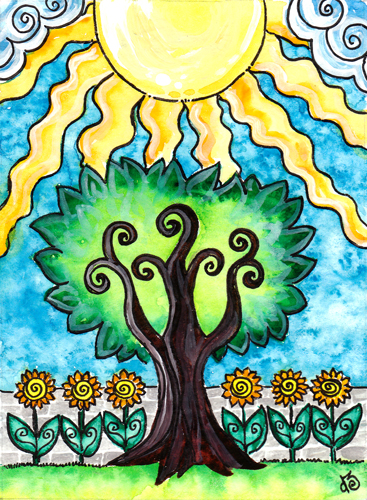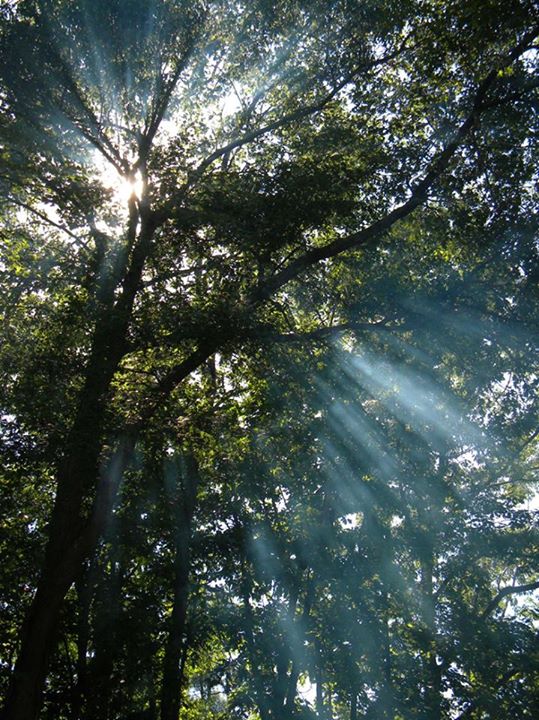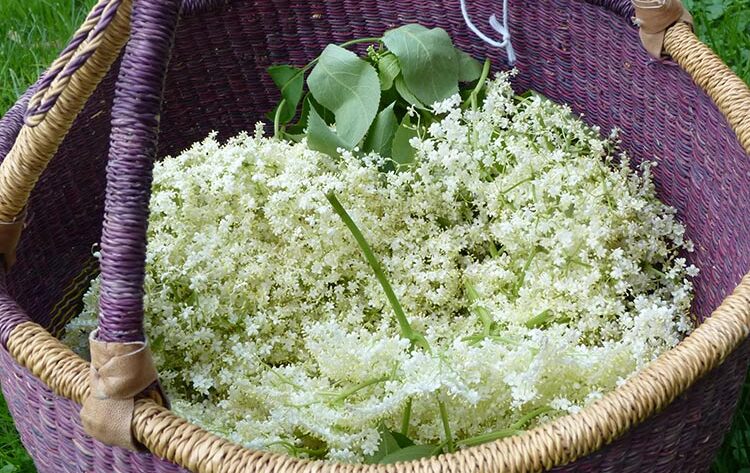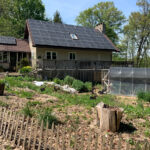The Summer Solstice, what we call “Alban Hefin” in the Druid Revival tradition, marks the beginning of high summer in my part of the world, and many activities of this time period focus on harvesting and honoring the power of the sun and thinking about the energy present in our lives. This is the time of light, laughter, growth, and movement! This is the time when people are outside, doing things, enjoying the warmth that the sun provides. The summer solstice gives us many opportunities to deepen our awareness and connection with the land and understand the relationship between earth and sky. (For my blog readers living in the southern hemisphere, see my post on the Winter Solstice for more appropriate activities for your Solstice!) Here are some activities that allow us to live in both a spiritual and sustainable manner:

1) Solstice herb gathering and medicine making. Some of my favorite plant allies are coming into bloom at the solstice and are ready to harvest–garden herbs like mint, lemon balm, sage, and thyme. Many leafy allies like strawberry leaf, raspberry leaf, plantain, and violet leaf–four of my most important leafy herbs for healing. Elder flower is typically also in full bloom–a critical medicinal. I always gather these on the summer solstice. These are all gentle herbs: strawberry leaf is a gentle astringent, great for conjunctivitis; violet leaf is a gentle demulcent, which coats and soothes (also good for conjunctivitis); plantain does a bit of everything (more on this plant soon); raspberry leaf is great for women’s issues; elder flower aids the body during influenza (and these plants all do so much more). I harvest these, tincture them, or dry them in a dehydrator or solar dehydrator.
2) Explore solar cooking. Solar cooking was quite a big deal back before electricity, and even in the 1970’s in the USA–and for good reason: anytime we can use the sun over gas, electric, or wood, we will have minimized our impact on the land. Even more–since we now cook with gas, and a lot gas is extracted through fracking, the less demand we can create for gas, the better. One of my friends has a great solar cooker oven from the 1970’s and we’ve had fun cooking beans, casseroles, and more in it–I hope to build one of my own sometime soon. Even a super-simple design, a cardboard box with tin foil, can make a very effective solar oven. I’ve been working on such an oven (using plans found here) to process my beeswax from my bees–solar approaches work best!
3) Making an energizing, herbal sun tea. Because the sun is an energizing force of nature, and because it is at its height on the day of the solstice, I like to make an energizing sun tea from some of those herbs. To make a sun tea, you simply place your herbs in a glass mason jar with water and let it sit in the direct sun for 4-6 hours. Dried herbs work better for teas than fresh because when they are dried, the cell walls break down. If you are using fresh herbs, you can grind them up a bit with a mortar and pestle to break down the cell walls (or put them in the freezer for about an hour–both will do the trick!). Obviously, your tea is being cooked by the energy of the sun rather than fossil fuels, which is sustainable. But its more than that–energetically, the solar current infuses the tea, allowing you to take its cleansing rays within. What I like to do is make a few different teas that day in mason jars, then leave them in the fridge and drink them over the next few days. Its a lovely, simple ritual to do with candles, hot baths, etc–have your daily herbal energizing tea.

What kind of tea do you want to make? As a traditional western herbalist, I believe that the tea should fit the person, their energetic state, and their needs. Here are a few possibilities based on what you are needing at the time.
A general revitalizing tea could include any of the following revitalizing herbs: Astragalus, nettle, ginseng, fo-ti, milky oats or oatstraw, reishi. (I usually use herbs more local, and not all of these are). I would most certainly add raw honey after the tea was made. I would make the tea with one or more of the above and then add any of the following herbs based on what you wanted to accomplish:
- Mental clarity/revitalizing: holy basil, lavender, sage, rosemary, passion flower
- Rest/relaxation: Catnip, Lemon balm, blue vervain (for people who take on too much and are always busy and just need to stop), chamomile
- Emotional revitalization: St. John’s Wort, Hawthorn, Hops, Wood Betony, Skullcap
- Physical exhaustion: Licorice, Schizandra, Kava Kava (will be tingly in the mouth), Chamomile
So, if I had just gone through a divorce or breakup and really wanted some healing, I would start with nettles, gathered locally the day or two before the Solstice, and then, add hawthorn, st. johns wort, and lemon balm (for example). If I was really physically tired, I’d do astragalus, nettle, ginsing, and schizandra. And so on. You can mix and match–but be warned, not all of these herbs taste awesome (reishi, for one, is an acquired taste; not everyone likes licorice, and so on). Not all of them taste particularly awesome together, so you might want to get a few jars and see what combinations you like or test in advance. You can also add less of the herb that tastes not so great–tea making is an art into and of itself!
You can also add some kind of regular tea to the herbs–like a green tea. I use red rooibos or green rooibos for this sometimes. For the herbs that aren’t locally available or ethical to harvest, you can get them from Mountain Rose Herbs.

4) Put up a clothesline. There is nothing quite like the freshness of clothes that have been hung out on a line to dry. When I visited Costa Rica, families washed their clothes by hand and everywhere you went, the laundry was hanging out to dry and was beautiful in the breeze. We see this less and less in the states, and its a sad thing! This very simple act can save tremendous amounts of fossil fuel energy over the course of a year–and your clothes are blessed by the energy of the sun and wind.
5) Build a solar dehydrator. Solar dehydrator plans are abundant online and function on some simple premises: collecting and directing the heat of the sun for drying purposes. I have built several working prototypes of solar dehydrators out of thick cardboard and was impressed by how well even these worked (plans can be found here at Mother Earth News). My friend with the solar cooker also has built a full-scale solar dehydrator and I’ve visited farms with various sizes and models–if you have a garden, do any foraging, or practice any herbalism, these are well worth your time to construct!
6) Explore solar showers and hot water heaters. Solar showers and hot water heaters are another fantastic way of harnessing the sun’s energy for your comfort and to reduce your dependency on fossil fuels. These run from very simple systems; a black bag or bucket (perhaps connected to a rainwater harvest system) that has a valve, hose, and shower head, to fully elaborated systems that are integrated into someone’s house and attached to the roof. In each case, water is cycled through tubes with a black surface and then is stored till use. I’ve experimented mostly with the simple “camp” showers thus far, but I have plans for more elaborated solar shower systems in the future! If you have any kind of solar shower, the solstice is a great time to take an “energizing shower” that day!

7) Mushroom logs and mushroom bed cultivation. Another great activity to get into during the summer months is mushroom cultivation. This may mean creating mushroom logs or establishing mushroom beds (see my blog posts on mushrooms here and here). I have experimented with three kinds of mushroom cultivation: inoculating freshly-cut logs; creating a mushroom bed; and growing oysters indoors. Kits are available for you to get started!
8) Rainwater harvesting. Before you begin rainwater harvesting, check the local laws in your area. Some places have made it illegal to harvest your own rainwater (which I find abhorrent; most of these restrictions are due to lobbying by industrialized agriculture and unsustainable uses of water). Rainwater harvesting can be done in two ways: 1) through the catchment and cistern system and 2) through diverting water in the landscape itself using a raingarden or swale system (building swales to collect passively is not illegal anywhere, as far as I know).
I’ve been wary using a rain catchment system on my home because I had to put a new roof on the house only a few years ago and I’m not sure about the chemicals in asphalt shingles (everything I’ve read indicates its not good). When I visited Costa Rica, everyone used metal roofs and many had simple rainwater harvesting systems that diverted into their gardens.
The second option, the swale, is a feature you can build into the existing landscape, often on a hill. I built mini swales into a hill behind my barn in Michigan to provide my fruit trees I planted there with extra nourishment. I also built a runoff trench to harvest water from my gravel driveway into a mushroom garden–these worked so well, and the year we were in drought, those trees were still strong and healthy because of the extra water.
9. Stormwater runoff awareness raising and monitoring. Stormwater is a huge environmental issue that has gotten little attention or notice, and with high summer comes more and more storms. As we create more and more houses, more and more paved streets and parking lots, water has less chance to absorb directly into the ground and more toxins run from the streets into our waterways. This causes substantial problems for our water, and as we have become so painfully aware of in recent years, water is a scarce resource worth protecting. One way we can protect our waterways is with better stormwater management. We can address this in our own landscapes and also in our communities by educating ourselves and taking action. Part of the reason this is a good idea in the summer months is because this is when a lot of new construction happens, and new construction often damages rivers and streams. For example, in my local community, they were building a new bridge and had inappropriate protections for water runoff from the concrete on the site. A friend of mine who was educated in stormwater taught me about what was going on and showed me the site, and was actively involved in educating our township about what they needed to do differently. Sometimes, you can learn and become the eyes and ears for a whole waterway–an activity well worth pursuing. A good site to learn more is Stormwater Awareness.
10. Simple Sunbathing Ritual. In the AODA tradition, we work with three currents of energy: the Solar (sun), the Telluric (earth) and the Lunar (that which is awakened from the elements and the solar and telluric currents). The sun is a purifying and energizing force. As the most simple of rituals on this day, I will go into a natural area and find a place where the sun is shining down (a clearing in a forest or field does this well). I’ll lay down a blanket in the sun then I will open up a sacred space in my tradition (for those that are new to this, in my tradition this means declaring my intentions, declaring peace in the four directions, purification with the four elements, and calling in the elements, and establishing a protective energetic sphere). After this, I will simply lay in the sun (I usually cover my face to do this). If the space is particularly private, I may lay in the sun without any clothing; otherwise, I’ll wear a swimming suit. I focus on my breathing during this time, doing color breathing (John Michael Greer describes this technique in several places, including the Druidry Handbook and Druid Magic Handbook). I often combine this 15 minute practice with my other celebratory rituals for the day, with this coming at the end of a celebration.
Just 15 minutes of direct sunlight gives you your vitamin D for the day, especially when the sun is at its height this time of a year. Even my fair Irish skin doesn’t burn in 15 minutes, once a year, unprotected :P.

11. Learn foraging. Wild food and medicine foraging is a wonderful thing to learn around the time of the solstice. The plants are in full bloom, in the weeks following the solstice, in my bioregion, the first of the summer mushrooms and berries are coming in (Mulberry, blackberry, black raspberry, thimbleberry, blueberry, etc). Its a great time to get outside and see what you can find! I have many posts dedicated to this practice on my blog, and I suggest you start with my two-part posts on how to forage, ethics, safety, and more.
12. Holding a Vigil and Honoring the Sunrise. Another thing I like to do on both of the solstices is holding a vigil and being awake to see the sun rise. I think on these two days its important to greet the sun, as it is the giver of all life on earth, and on this day, we honor the sun. For the winter solstice, this practice usually involves an all-night vigil with fire and friends. For the summer solstice, I like to camp, and then wake up prior to sunrise so I can watch the sun coming in. I also make sure I am there to observe the sunset on that day. I have written songs for my flute to honor the sunrise, and I play the sunrise song and sit in meditation and joy as the sun rises over the hills and up through the trees!
13. Make some solstice jam. One of the things I do every year on the solstice is to make some jam. The three plants I can harvest that are always ready this time of year are serviceberry (wild foraged), strawberry (grown or purchased from farmers) and rhubarb. All of the jams I make these days are using Pomona’s pectin, a low-sugar or sugar-free pectin that allows you to can with small amounts of sugar, maple syrup, stevia, or honey. You can get at Whole Foods or other health stores or order online–totally worth it. Usually I use honey from my hives. Here are the jams I can make that are in season at the Summer Solstice (yours may be a bit different!):
- A straight serviceberry jam (using a bit of honey)
- A strawberry jam of some kind; I’ve done strawberry vanilla, strawberry mint, and strawberry ginger (here’s a recipe for strawberry ginger)
- A rhubarb jam of some kind (here’s a recipe for straight rhubarb; I modify this to add orange juice instead of lemon juice and add orange peels and its amazing! Here’s one for cherry-rhubarb, which I replace with strawberries)
- An herb jelly (recipe here).
What is so wonderful about canning jam on the summer solstice is that it makes amazing gifts, especially at the Winter Solstice. People LOVE getting a jam that contains the energy of the sun–that’s essentially what you do when you can on this day! Bottle up the sun’s energy and save it for the dark months.
Thank you for reading, and I wish everyone an amazing Summer Solstice!





Thank you again for some wonderful information. Thank you for being so generous with your knowledge! Happy Solstice Willowcrow!
Happy solstice to you as well! Thanks for commenting 🙂
Such beautiful reminders and suggestions…love them, all, I do.
It’s almost a handbook of “rivalists” in a world of “survivalists”
Seeing the peace, within and without!
Observer Jules
Thank you, Jules. Peace within and without to you as well!
Hi, thank you for your most informative newsletters. This year I decided to study Druidism. It’s somewhat difficult as there are no Druids that I know of in my area. I live in Australia. We don’t own a clothes dryer and everything is hung on the line. I would like to have a hand rotated washer. I have a chronic condition that wouldn’t allow me to wash by hand. I want to go as green as possible. I am going blind so foraging might not be advisable as I live in a snake infested climate. But I do love the idea of natural foods that harness the suns energy. Are night shade vegetables also of benefit? I will have a go at solar oven. I feel very encouraged by your efforts and thankful for your sharing. I want to grow things. The soil here is acid sulphate. Not much seems to grow and green things turn yellow and don’t taste as they should. Such is the legacy of sugar cane farming in the area and the run off of toxins from the cane fields. I am looking for a way to bring the soil back to good health before next spring.
I look forward to your next newsletter.
Kind Regards,
Janet
Sent from my iPhone
>
Hi Janet – Concerning druids in Australia: check out the Order of Bards, Ovates and Druids (this is one of my two driud orders). I found this site: http://www.druidryaustralia.org/
I’m so sorry to hear about you going blind. I have a good friend of mine who recently also went blind, and I’m amazed at her power and strength. I believe that if you set your will to it–you can do anything, even given limitations! I would say go with tactile vegetables and those you could identify by shape and smell–I’m thinking about veggies that do well in hot, dry climates: any nightshades (eggplant, peppers, tomatoes), basil, even kale would probably do ok!
Now about that soil. I need to write a post on soil and soil building. Certain plants do like acidic soil, notably, blueberries–but depending on your climate, it might be too dry and hot. Adding any kind of organic matter you can get your hands on is good–animal manure is my favorite, as is fall leaves, animal muck/bedding, compost, and so on. The more you add, the more you build fertility and the higher you will raise the PH.
Raised beds are another option for poor soils, cause you are adding soil on TOP of the existing soil. The raised beds may also be beneficial for low vision because you will be able to feel the edges of the garden.
Concerning toxin runoff, can you divert that runoff somehow? Keep it away from your beds?
Thanks for commenting! 🙂
Reblogged this on Forever Unlimited and commented:
Some wonderful ways to celebrate the arrival of summer!
Thank you for the reblog! 🙂
Reblogged this on Rattiesforeverworldpresscom.
Thank you for such words of wisdom
You are most welcome :). Thank you for reading!